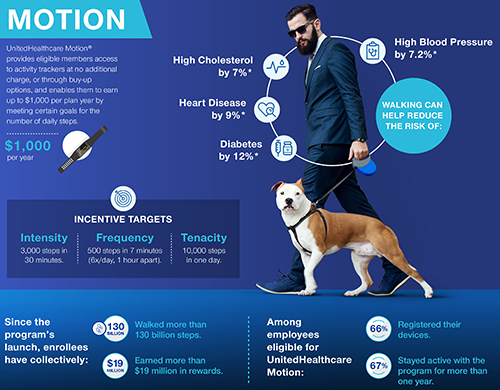Mobile, wearable, mHealth monitoring devices are a key element of many employer fitness programs and clinical laboratories can play an important role in their success
For years Dark Daily has encouraged clinical laboratories to get involved in corporate wellness programs as a way to support their local communities and increase revenues. Now, leveraging the popularity of mobile health (mHealth) wearable devices, UnitedHealthcare (UHC) has found a new way to incentivize employees participating in the insurer’s Motion walking program. UHC is offering free Apple Watches to employees willing to meet or exceed certain fitness goals.
This is the latest wrinkle in a well-established trend of incentivizing beneficiaries to meet healthcare goals, such as stopping smoking, losing weight, reducing cholesterol, and lowering blood pressure.
It’s an intriguing gamble by UHC and presents another opportunity for medical laboratories that are equipped to monitor and validate participants’ progress and physical conditions.
How to Get a Free Apple Watch and FIT at the Same Time
CNBC reported that UHC’s Motion program participants number in the hundreds of thousands. And, according to a UHC news release, they can earn cash rewards up to $1,000 per year. The idea is that participants pay off the cost of their “free” Apple Watch one day at a time by achieving activity goals set in UHC’s FIT tracking method. Those goals include:
- Frequency: 500 steps in seven minutes; six times a day, at least one hour apart;
- Intensity: 3,000 steps in 30 minutes; and,
- Tenacity: 10,000 steps in one day.

Though hundreds of thousands of beneficiaries are eligible to participate in UHC’s Motion program through their employers, only 45% of those eligible have enrolled in Motion, Fox Business reported.
UHC hopes the offer of a free Apple Watch (which has applications to track minutes of exercise, a heart rate monitor, and more) will encourage people to sign up and then progress toward the Motion program’s FIT goals.
As people meet these goals, they earn $4/day toward the cost of the Apple Watch. Participants, who do not take enough steps in a six-month period could be required to repay a percentage of the cost of the smartwatch.
Motion participants who already own an Apple Watch can still earn up to $1,000 per year in cash rewards for achieving the FIT goals.

Impact of mHealth Programs/Technology Not Clear
Chronic diseases, including diabetes and heart disease, annually cost the US healthcare system $190 billion and employers $126 billion in lost productivity, according to the Centers for Disease Control and Prevention (CDC).
However, some researchers say it’s too early for mHealth wearables, medication apps, physician virtual engagement, and other digital tools (many launched within the past five to seven years) to effect key indicators, such as obesity, life expectancy, and smoking cessation.
“Some of the benefits of these new tools won’t be realized for a long time. It’s really hard to tease out the impact of digital health. Maybe we’re helping people, but we’re not detecting it,” James Murphy, MD, Associate Professor, University of California San Diego Health and radiation oncologist, told CNBC.
Nevertheless, it behooves medical laboratories to develop procedures for analyzing and reporting data that could impact people who use wearable mHealth devices to participate in employer wellness programs.
For example, labs could contact insurance companies with information about biomarkers that provide views into an individual’s progress toward personal health goals.
Data-driven recommendations from medical laboratories about tests for chronic conditions such as heart disease and diabetes will likely be welcomed by payers.
—Donna Marie Pocius
Related Information:
A Giant Insurer is Offering Free Apple Watches to Customers Who Meet Walking Goals
UnitedHealthcare Offer Provides Free Apple Watch Series 3 if Customers Exercise Daily
UnitedHealth Offering Americans Free Apple Watch if They Do This
Monitoring Your Daily Activity is now as easy as Looking at Your Watch for the Time
UnitedHealthcare Helps People Be More Active with Apple Watch
Fulfilling Digital Health’s Promise
Billions are Pouring into Digital Health, but Americans are Still Getting Sicker and Dying Younger




It is a great idea, I love it, but they shouldn’t exclude those that have an FSA account. I don’t have an HSA account but I am paying a high premium for my UHC insurance. I should have the same benefit participating in the Motion program.